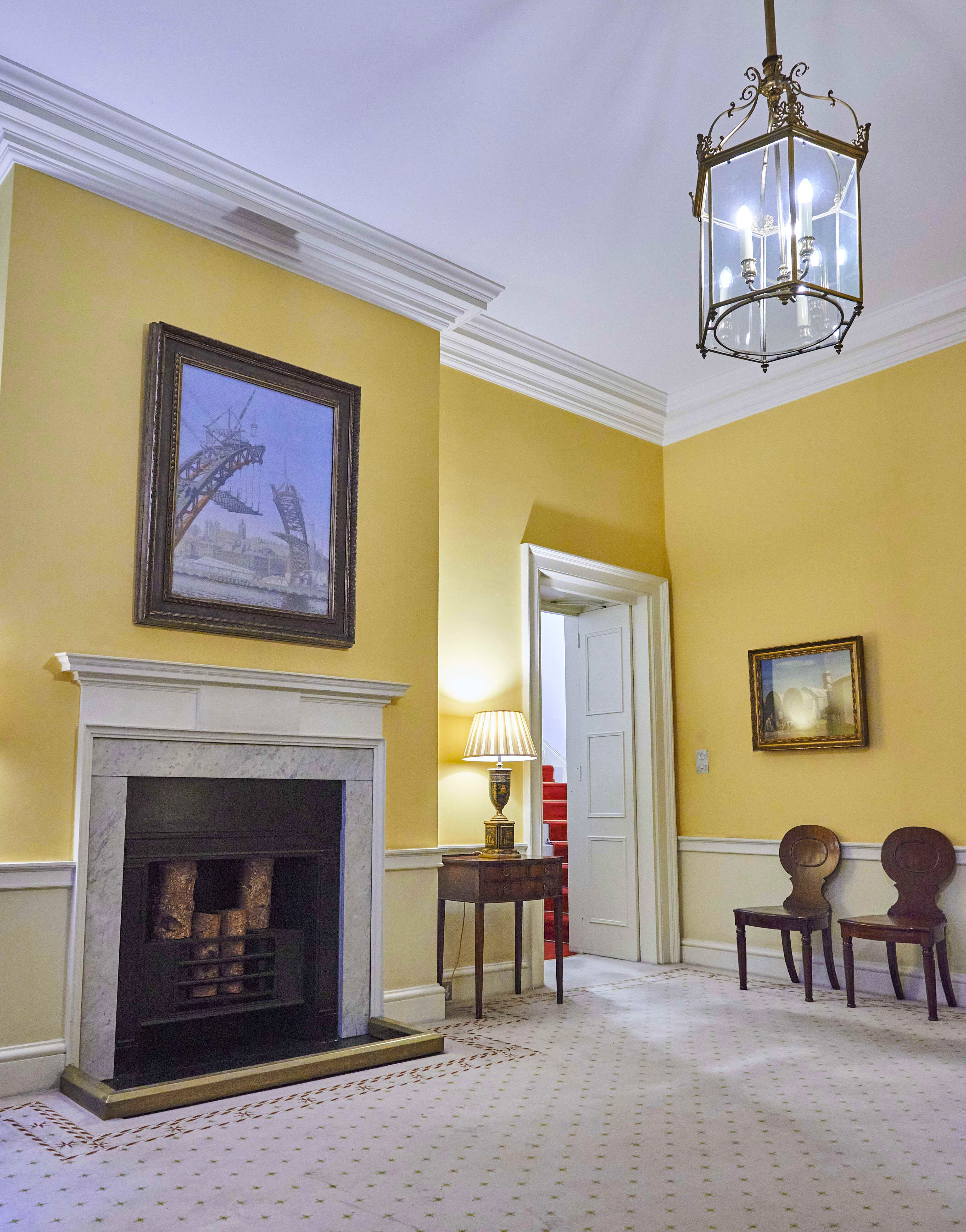Laing Art Gallery artworks on display at 10 Downing Street
12 January 2024

Image: Edward Dickey's, The Building of the Tyne Bridge (1928) from the Laing Art Gallery collection on display above a fireplace in 10 Downing Street
Nine artworks from the Laing Art Gallery collection in Newcastle have gone on display in 10 Downing Street’s corridor leading from the famous black door through to the Cabinet Room.
The artworks will remain in the corridor for a year, as part of the Government Art Collection’s ‘Number 10 Museum in Residence’ project and will be seen by world leaders and high-profile guests attending events in the building.
For the past twenty years, the Government Art Collection has instigated an annual partnership with a museum or gallery across the UK to display artworks from their collection. Previous galleries include the Glynn Vivian in Swansea, The Whitworth Art Gallery in Manchester and The New Art Gallery in Walsall.
The nine chosen works from the Laing Art Gallery, are representative of the city and the wider North East of England. Five of the paintings showcase Newcastle’s cityscape, while the others point to the diverse art scene of the North East. All of the works are by influential artists from the area, who taught at its art schools, or who have been inspired by its landmarks and landscapes.
Paintings in the display include a large oil painting by Edward Dickey, depicting the iconic Tyne Bridge mid-construction, and Caravans, Figures and Helter Skelter, a work from 1930 by Byron Dawson that shows a scene from the long-running travelling fair The Hoppings, which sets up on the Town Moor annually. There are also several mid-20th-century works by figures associated with the region’s progressive art schools such as graduates of King’s College (now Newcastle University).
Arts and Heritage Minister Lord Parkinson of Whitley Bay said:
“The Museum in Residence scheme helps to ensure that visitors to 10 Downing Streetget a glimpse of the brilliant range of artistic talent the UK has to offer.
“I’m delighted that visitors over the next year will get to learn more about the proud culture and rich heritage of Tyneside thanks to this partnership with the Laing Art Gallery. The first thing they’ll see after walking through that famous front door is a huge portrait of the Tyne Bridge, which fills my Geordie heart with pride.”
Julie Milne, Chief Curator of Art Galleries at Tyne & Wear Archives & Museums, said:
“We have enjoyed working with the Government Art Collection team in selecting paintings from the Laing Art Gallery. It has enabled us to see the works from a fresh perspective – to hone and highlight narratives about the North East. We are delighted that our wonderful pictures will be seen by a range of people, from the UK and around the world, as they pass through the doors of Number 10.”
Works are selected on the basis that they are not part of the lending gallery’s programme over the period of the display, giving them an opportunity to be seen by new people.
The Government Art Collection
The Government Art Collection, established in 1899, is a national collection of historic, modern and contemporary British art that is displayed in government buildings in the UK and around the world. These locations include 10 & 11 Downing Street, government departments and residences and offices of British Ambassadors, High Commissioners and Consulates-General in over 125 countries worldwide. The works are seen by thousands of visitors, promoting British art, history and culture, and contributing to cultural diplomacy. We actively seek ways to widen engagement with collection works through partnerships and by participating in local, national and international projects. www.artcollection.culture.gov....
The Laing Art Gallery
The Laing Art Gallery is managed by Tyne & Wear Archives & Museums on behalf of Newcastle City Council. Located in the heart of Newcastle upon Tyne the Laing Art Gallery was founded in 1901 by local businessman and philanthropist Alexander Laing. Laing commissioned the baroque-style building but left no art collection to adorn its walls, though donations of art flooded in once the gallery opened. Today it holds an internationally important collection of British oil paintings, watercolours, ceramics, silver and glassware and hosts regular exhibitions of historic and contemporary art. https://laingartgallery.org.uk...
Full list of artworks:
Edward Dickey, The Building of the Tyne Bridge (1928)
This dramatic painting depicts the final stages of construction on Newcastle’s most recognisable landmark, the Tyne Bridge. The bridge, which links Newcastle upon Tyne and Gateshead, was opened in 1928 and remains an iconic landmark today. It is shown here mid assembly – with the two sides of its distinctive parabolic arch coming together and a crane swinging overhead.
Norman Cornish, Pit Road (c.1960)
This painting, by coal-miner turned art teacher Norman Cornish, captures a scene of a miner returning from work through a dramatic colour palette and vigorous, bold paint strokes. In its background details it gestures to the source of Newcastle’s wealth in coal, a heap of which is visible beyond the fence
Louis Grimshaw, St Nicholas Street (1902)
This painting shows the brightly-lit shops of Newcastle’s St Nicholas Street, with the spire of the Gothic Church of St Nicholas visible at its centre. The artist, Louis Grimshaw, mainly painted in London but appears to have made a short visit to Newcastle in 1902. Grimshaw was one of a family of artists who specialised in painting the streets and docklands of England's northern cities, following in the footsteps of their father, John Atkinson Grimshaw. Following his career as a painter, Grimshaw abandoned painting in 1905 to become a cartographer.
Arthur Grimshaw, The Quayside (1895)
In this painting a man pushes a cart across tramlines on the Newcastle Quayside. Yellow light shines out from the shops, while the silvery light of the moon is reflected on the wet cobbles. The artist, Arthur Grimshaw, was one of a family of artists based in Leeds who specialised in painting the streets and docklands of England's northern cities. He was also a successful composer, organist and conductor.
Byron Dawson, Caravans, Figures & Helter Skelter (1930)
This intriguing painting depicts a scene from The Hoppings, a long-running travelling fair that has been set up annually on the Town Moor at the centre of Newcastle since 1882 and, to this day, plays host to the type of traditional caravan included by the artist.
Victor Pasmore, Girl with Mirror (c.1942–5)
This painting is a rare example of a figurative work from a painter better known for his energetic abstract compositions. Its subject, Wendy Pasmore, a painter and the wife of the artist, is captured in diagonal lines and given lightness through a careful use of colour. During the 1950s and 1960s, Pasmore, along with fellow art teacher Richard Hamilton, made Newcastle a centre for British Art and, via Bauhaus philosophy, developed a model for UK higher arts education that remains in use today.
Flora Glover, The Flood (c.1941)
In this compelling painting, Glover translates the biblical story of Noah’s Ark into 20th-century form through the use of a mid-century palette and cubist sensibilities. Glover was a graduate of King’s College (now Newcastle University) and a highly skilled artist, creating work up until her untimely death in 1946.
Florence Ward, Quartz Inset (c. 1965)
Born at Dunston, near Gateshead, Ward studied at King’s College (now Newcastle University) and exhibited widely in northeast England in later years. Ward was fascinated by local rural landscapes and sought to recreate them in her work. Here she uses plaster to echo the texture of cut quartz.
Kenneth Rowntree, West Front, Durham (1974)
This piece, possibly constructed from a tea chest, uses collage to depict the Western facade of Durham’s mighty cathedral. Rowntree, who was Professor of Fine Art at Newcastle University between 1959 to 1980, uses the overlapping surfaces of wood to create depth and to mimic the play of light on the Cathedral’s outer walls.


